60th Venice Biennial
Under the general curatorship of Adriano Pedrosa, the 60th Venice Biennale is more political than ever. From the pavilions of the Giardini to the palaces of Venice, we discover forms that are as contemporary as the causes they champion.
Immersion
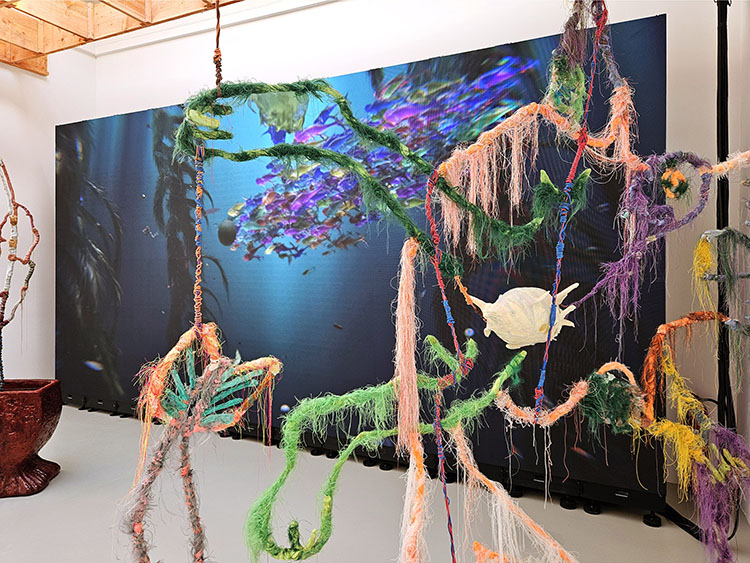
Julien Creuzet, Attila cataracte ta source aux pieds des pitons verts finira dans la grande mer gouffre bleu nous nous noyâmes dans les larmes marées de la lune, 2024.
The French Pavilion, awarded to Julien Creuzet for this biennale, features a host of sculptures delicately linked together by coloured fibres whose nature and provenance are unknown. To watch the animated sequences, in which other objects are immersed in seas, possibly the Caribbean, you need to walk around them. The booming bass of the music, which also fills the space, resonates to the bone. Bodies contort as our gazes sweep across the space, where the fibres continue on large screens. There is no title for this all-embracing work of art, but there is a poem that propels us into the elsewhere of the artist's thoughts: “Attila cataract your source at the feet of the green peaks will end up in the great sea blue abyss we drowned in the tidal tears of the moon."
Hope for elsewhere
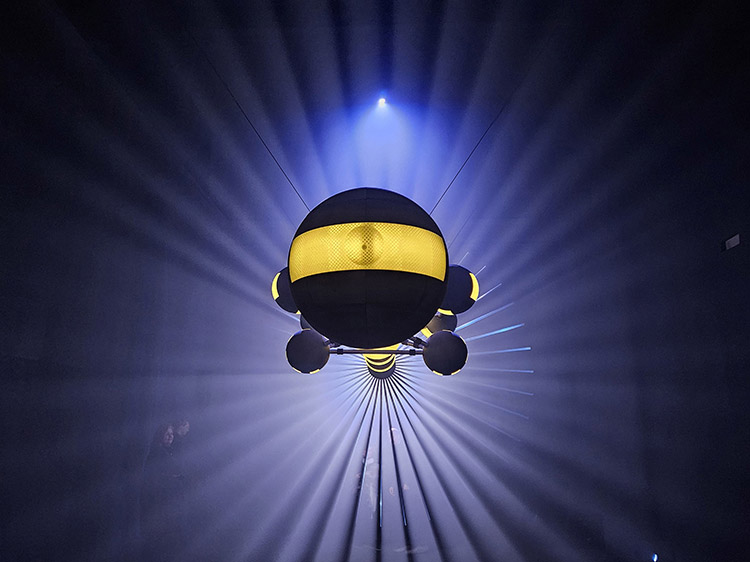
Yael Bartana, Light of Nations, 2023.
Yael Bartana is one of the artists representing Germany this year. Her creations are part of an integral work of art entitled Thresholds. And her approach is entirely consistent with the general theme of this Biennial: Foreigners Everywhere. It is a space voyage, possibly without return, of a group of humans symbolising the hope of humanity that she is staging. At the entrance, the imposing kinetic and luminous sculpture of the spaceship embodies the promise of a second Earth. The spaceship also forms part of the film in the centre of the pavilion, documenting some disturbingly strange ritual dances. In these troubled times, when so many conflicts are shaking the world, even in the aisles of the Giardini, could the idea of a global catastrophe be conducive to reconciliation?
Acting on the world
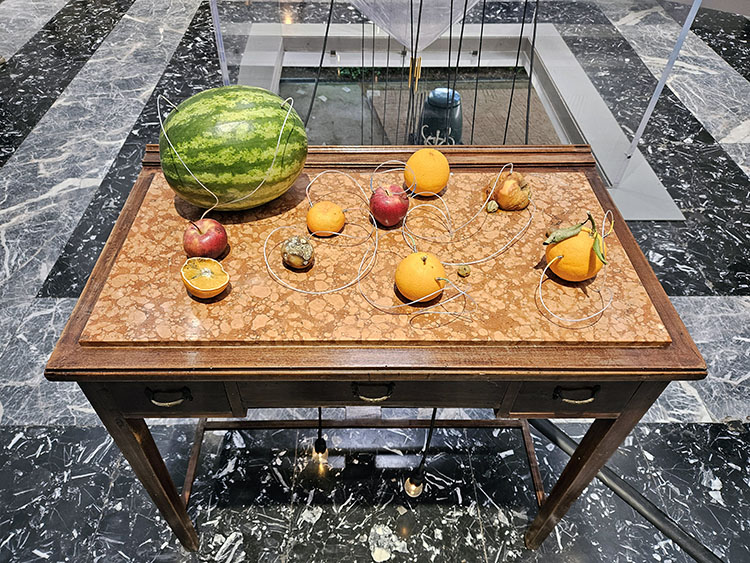
Yuko Mohri, Compose, 2024.
In the Japanese Pavilion, Yuko Mohri is carrying out small experiments that form an artistic whole. The artist, known for her interest in the infinitesimal, connects fruit via electrodes and cables to microcontrollers to power light bulbs and modulate sounds. This phenomenon, which is well known in the international Do It Yourself community, is nevertheless intriguing for the art public in Venice. What's more, it's raising awareness of actions that, while seemingly insignificant, can have an impact on the world when carried out on a large scale. For it is by combining our efforts that we can collectively take action for the climate, at a time when the carbon impact of contemporary art needs to be considered, and when ecology is one of the fundamental causes of this Biennale.
The subject of the work

Pierre Huyghe, Offspring, 2018.
The Pinault Collection has a habit of synchronising its exhibitions with the event, and the one at the Punta della Dogana, entitled Liminal, is entirely dedicated to Pierre Huyghe. The installations, which have no labels, form a whole in which the artist's work is gradually revealed through pieces such as Offspring, a sound and light installation whose poetic power is heightened by white smoke. It follows on from an earlier work (L'Expédition Scintillante, 2002) based on Erik Satie's Gymnopédies 3 and 4. The generative system of this new device enables it to integrate changes in its immediate environment to generate infinite variations on the composer's scores. In the words of Pierre Huyghe: "It's not a matter of showing something to someone so much as showing someone to something". Which makes the audience the real subject of the work.
The creation of stars
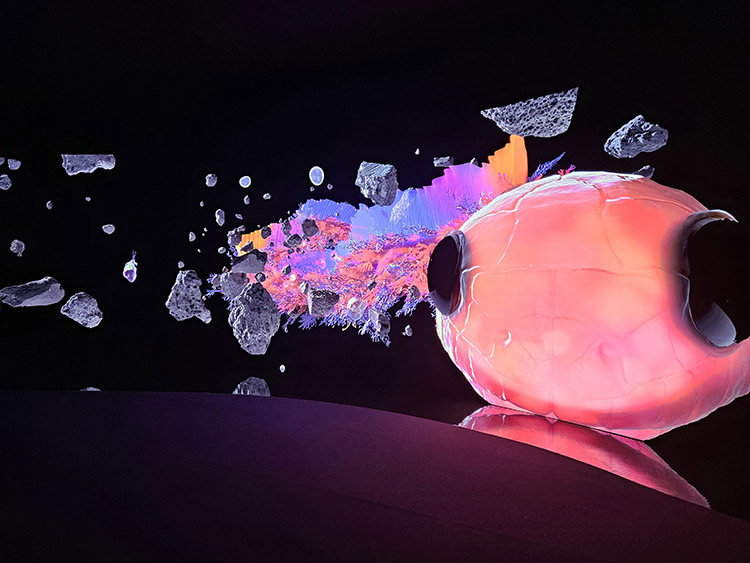
Josèfa Ntjam, Swell of spæc(i)es, 2024.
This year, the Berlin-based LAS Art Foundation, which explores the relationship between the arts, science and technology, set up shop in the courtyard of the Accademia di Belle Arti di Venezia, building a structure to house Josèfa Ntjam's Swell of Spæc(i)es exhibition. The electric blue prism of this temporary pavilion, designed by the architect Giulia Foscari, is integrated by contrast. Beyond its absolute minimalism, this architectural extension bathes the organic sculptures by the artist Josèfa Ntjam in a museum-like atmosphere set off by light. As for the film at the heart of the Swell of Spæc(i)es exhibition, it is a hybrid of different media and aesthetics, unified by a three-dimensional stage. Moving from the depths of the ocean to the far reaches of space, the narrative is inspired by Dogon cosmology, according to which the god Amma created the stars by throwing earth into the sky.
Of bodies and minds
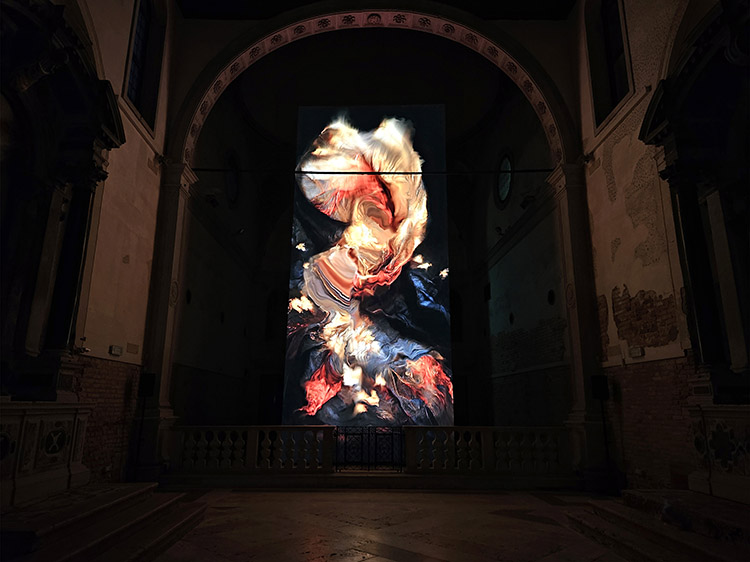
Memo Akten, Boundaries, 2023-2024.
Lastly, the Vanhaerents Art Collection in Brussels took over the Chiesa di Santa Maria della Visitazione in Zattere to present Memo Akten's Boundaries. The work was entirely conceived and produced by Memo Akten using generative artificial intelligence applications, which he was already making extensive use of before it became an art trend. The imposing LED wall in the choir of the church gives it a truly monumental feel. The relative slowness of the images and sounds that make up the Boundaries sequence literally acts on both our bodies and our minds. So much so that we have no alternative but to let ourselves be carried along by a flow in which nature intrudes into the ether. Our bodies are right here, while our minds gradually drift away to take in the matter of the images and the sounds, which seem to be carried by a stellar wave. This is how Memo Akten practises an art of escape that should be experienced right up until the end of this 60th Venice Biennial, on 24 November 2024.
Articles
- Paris Photo
- Art, technology and AI
- Immersive Art
- Chroniques Biennial
- 7th Elektra Biennial
- 60th Venice Biennial
- Endless Variations
- Multitude & Singularity
- Another perspective
- The Fusion of Possibilities
- Persistence & Exploration
- Image 3.0
- BioMedia
- 59th Venice Biennale
- Decision Making
- Intelligence in art
- Ars Electronica 2021
- Art & NFT
- Metamorphosis
- An atypical year
- Real Feelings
- Signal - Espace(s) Réciproque(s)
- On Combinations at Work
- Human Learning
- Attitudes and forms by women
- Ars Electronica 2019
- 58th Venice Biennale
- Art, Technology and Trends
- Art in Brussels
- Plurality Of Digital Practices
- The Chroniques Biennial
- Ars Electronica 2018
- Montreal BIAN 2018
- Art In The Age Of The Internet
- Art Brussels 2018
- At ZKM in Karlsruhe
- Lyon Biennale 2017
- Ars Electronica 2017
- Digital Media at Fresnoy
- Art Basel 2017
- 57th Venice Biennial
- Art Brussels 2017
- Ars Electronica, bits and atoms
- The BIAN Montreal: Automata
- Japan, art and innovation
- Electronic Superhighway
- Lyon Biennale 2015
- Ars Electronica 2015
- Art Basel 2015
- The WRO Biennale
- The 56th Venice Biennale
- TodaysArt, The Hague, 2014
- Ars Electronica 2014
- Basel - Digital in Art
- The BIAN Montreal: Physical/ity
- Berlin, festivals and galleries
- Unpainted Munich
- Lyon biennial and then
- Ars Electronica, Total Recall
- The 55th Venice Biennale
- The Elektra Festival of Montreal
- Digital practices of contemporary art
- Berlin, arts technologies and events
- Sound Art @ ZKM, MAC & 104
- Ars Electronica 2012
- Panorama, the fourteenth
- International Digital Arts Biennial
- ZKM, Transmediale, Ikeda and Bartholl
- The Gaîté Lyrique - a year already
- TodaysArt, Almost Cinema and STRP
- The Ars Electronica Festival in Linz
- 54th Venice Biennial
- Elektra, Montreal, 2011
- Pixelache, Helsinki, 2011
- Transmediale, Berlin, 2011
- The STRP festival of Eindhoven
- Ars Electronica repairs the world
- Festivals in the Île-de-France
- Trends in Art Today
- Emerging artistic practices
- The Angel of History
- The Lyon Biennial
- Ars Electronica, Human Nature
- The Venice Biennial
- Nemo & Co
- From Karlsruhe to Berlin
- Media Art in London
- Youniverse, the Seville Biennial
- Ars Electronica, a new cultural economy
- Social Networks and Sonic Practices
- Skin, Media and Interfaces
- Sparks, Pixels and Festivals
- Digital Art in Belgium
- Image Territories, The Fresnoy
- Ars Electronica, goodbye privacy
- Digital Art in Montreal
- C3, ZKM & V2
- Les arts médiatiques en Allemagne
- Grégory Chatonsky
- Le festival Arborescence 2006
- Sept ans d'Art Outsiders
- Le festival Ars Electronica 2006
- Le festival Sonar 2006
- La performance audiovisuelle
- Le festival Transmediale 2006
- Antoine Schmitt
- Eduardo Kac
- Captations et traitements temps réel
- Maurice Benayoun
- Japon, au pays des médias émergents
- Stéphane Maguet
- Les arts numériques à New York